Health Policy: Advocacy for SPYM India on Drug and Alcohol Addiction
VerifiedAdded on 2022/10/19
|14
|3503
|375
Report
AI Summary
This report focuses on health policy advocacy, specifically highlighting the work of SPYM India, a national NGO dedicated to community mobilization, socioeconomic development, and healthcare, particularly in the context of drug and alcohol addiction among young adults. The report details SPYM's mission, aims, and objectives, emphasizing their efforts in treatment, rehabilitation, and awareness programs. It provides a background on the health issue, discussing the causes and health effects of drug and alcohol addiction, with a particular focus on cardiovascular diseases. The report also outlines the aims and objectives of a policy of advocacy, seeking to reduce the impact of diseases and find solutions. It concludes with recommendations for SPYM India, suggesting the implementation of effective policies, mental disorder treatments, and HIV management strategies, drawing from various research journals to improve healthcare and address the growing challenges associated with substance abuse. The target population for this issue is between the ages of 12 to 28, as this age group is highly susceptible to addiction and lacks awareness regarding the harmful effects of drug and alcohol usage. The report emphasizes the importance of interventions by NGOs, government and parents to combat this growing issue.
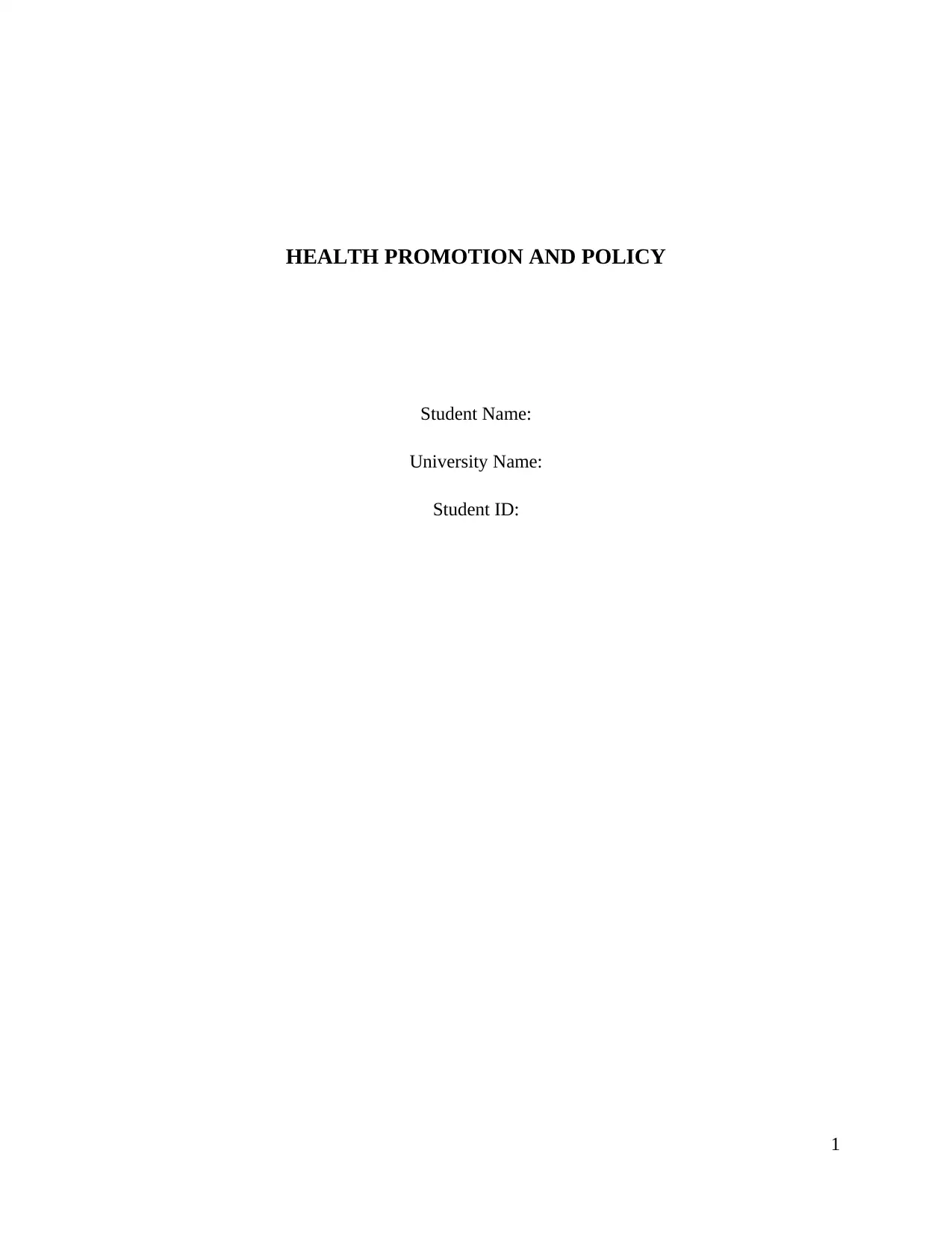
HEALTH PROMOTION AND POLICY
Student Name:
University Name:
Student ID:
1
Student Name:
University Name:
Student ID:
1
Paraphrase This Document
Need a fresh take? Get an instant paraphrase of this document with our AI Paraphraser
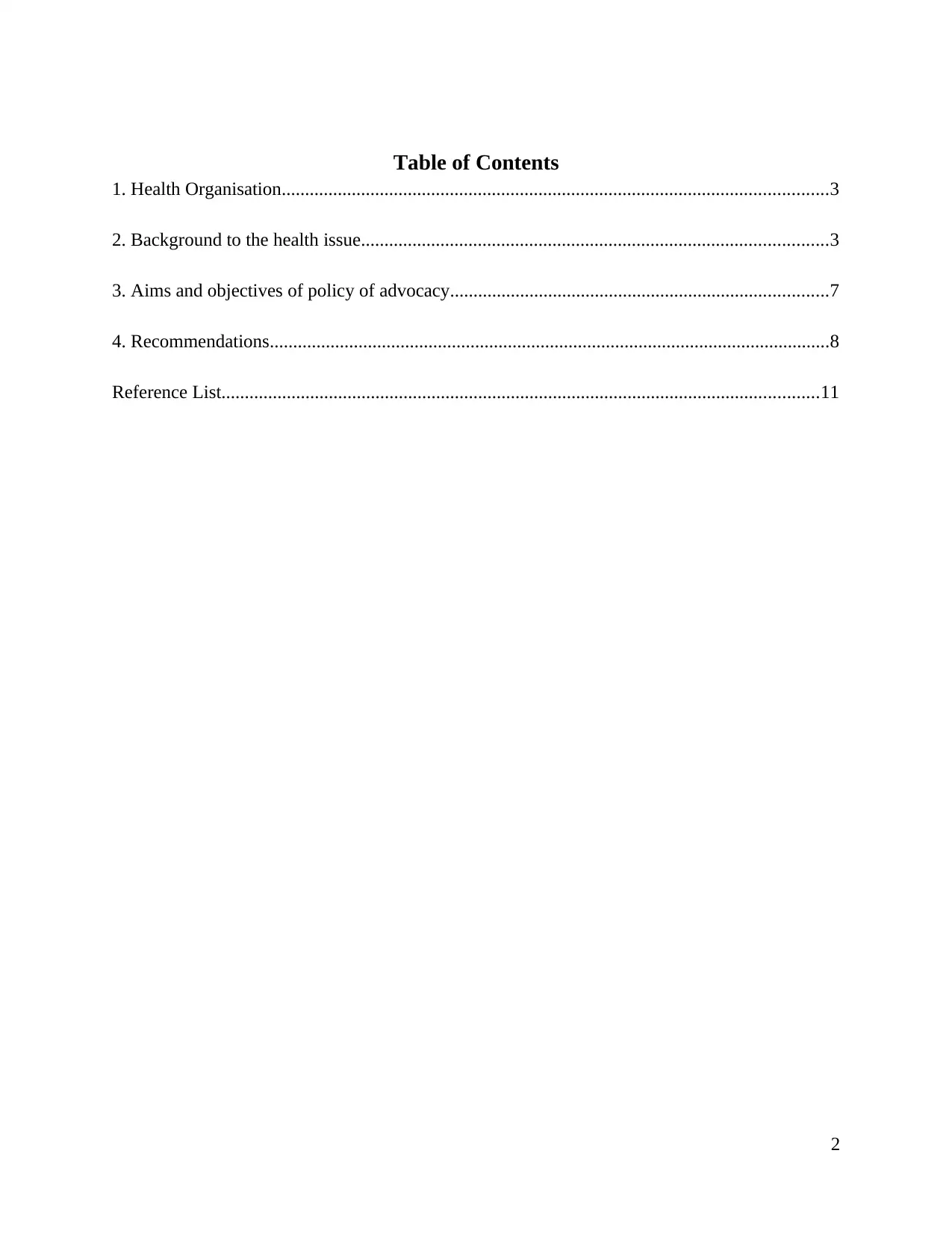
Table of Contents
1. Health Organisation.....................................................................................................................3
2. Background to the health issue....................................................................................................3
3. Aims and objectives of policy of advocacy.................................................................................7
4. Recommendations........................................................................................................................8
Reference List................................................................................................................................11
2
1. Health Organisation.....................................................................................................................3
2. Background to the health issue....................................................................................................3
3. Aims and objectives of policy of advocacy.................................................................................7
4. Recommendations........................................................................................................................8
Reference List................................................................................................................................11
2
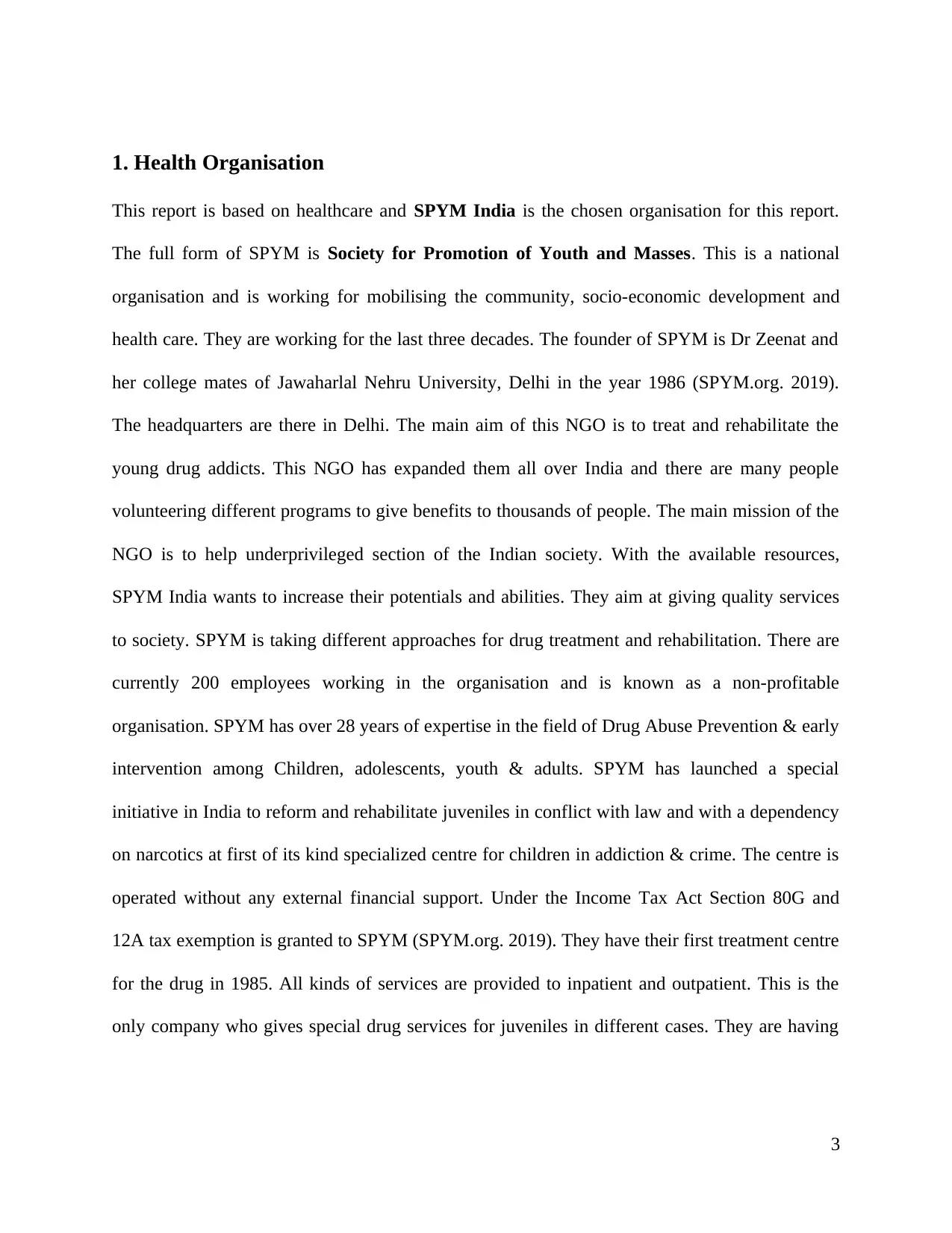
1. Health Organisation
This report is based on healthcare and SPYM India is the chosen organisation for this report.
The full form of SPYM is Society for Promotion of Youth and Masses. This is a national
organisation and is working for mobilising the community, socio-economic development and
health care. They are working for the last three decades. The founder of SPYM is Dr Zeenat and
her college mates of Jawaharlal Nehru University, Delhi in the year 1986 (SPYM.org. 2019).
The headquarters are there in Delhi. The main aim of this NGO is to treat and rehabilitate the
young drug addicts. This NGO has expanded them all over India and there are many people
volunteering different programs to give benefits to thousands of people. The main mission of the
NGO is to help underprivileged section of the Indian society. With the available resources,
SPYM India wants to increase their potentials and abilities. They aim at giving quality services
to society. SPYM is taking different approaches for drug treatment and rehabilitation. There are
currently 200 employees working in the organisation and is known as a non-profitable
organisation. SPYM has over 28 years of expertise in the field of Drug Abuse Prevention & early
intervention among Children, adolescents, youth & adults. SPYM has launched a special
initiative in India to reform and rehabilitate juveniles in conflict with law and with a dependency
on narcotics at first of its kind specialized centre for children in addiction & crime. The centre is
operated without any external financial support. Under the Income Tax Act Section 80G and
12A tax exemption is granted to SPYM (SPYM.org. 2019). They have their first treatment centre
for the drug in 1985. All kinds of services are provided to inpatient and outpatient. This is the
only company who gives special drug services for juveniles in different cases. They are having
3
This report is based on healthcare and SPYM India is the chosen organisation for this report.
The full form of SPYM is Society for Promotion of Youth and Masses. This is a national
organisation and is working for mobilising the community, socio-economic development and
health care. They are working for the last three decades. The founder of SPYM is Dr Zeenat and
her college mates of Jawaharlal Nehru University, Delhi in the year 1986 (SPYM.org. 2019).
The headquarters are there in Delhi. The main aim of this NGO is to treat and rehabilitate the
young drug addicts. This NGO has expanded them all over India and there are many people
volunteering different programs to give benefits to thousands of people. The main mission of the
NGO is to help underprivileged section of the Indian society. With the available resources,
SPYM India wants to increase their potentials and abilities. They aim at giving quality services
to society. SPYM is taking different approaches for drug treatment and rehabilitation. There are
currently 200 employees working in the organisation and is known as a non-profitable
organisation. SPYM has over 28 years of expertise in the field of Drug Abuse Prevention & early
intervention among Children, adolescents, youth & adults. SPYM has launched a special
initiative in India to reform and rehabilitate juveniles in conflict with law and with a dependency
on narcotics at first of its kind specialized centre for children in addiction & crime. The centre is
operated without any external financial support. Under the Income Tax Act Section 80G and
12A tax exemption is granted to SPYM (SPYM.org. 2019). They have their first treatment centre
for the drug in 1985. All kinds of services are provided to inpatient and outpatient. This is the
only company who gives special drug services for juveniles in different cases. They are having
3
⊘ This is a preview!⊘
Do you want full access?
Subscribe today to unlock all pages.

Trusted by 1+ million students worldwide
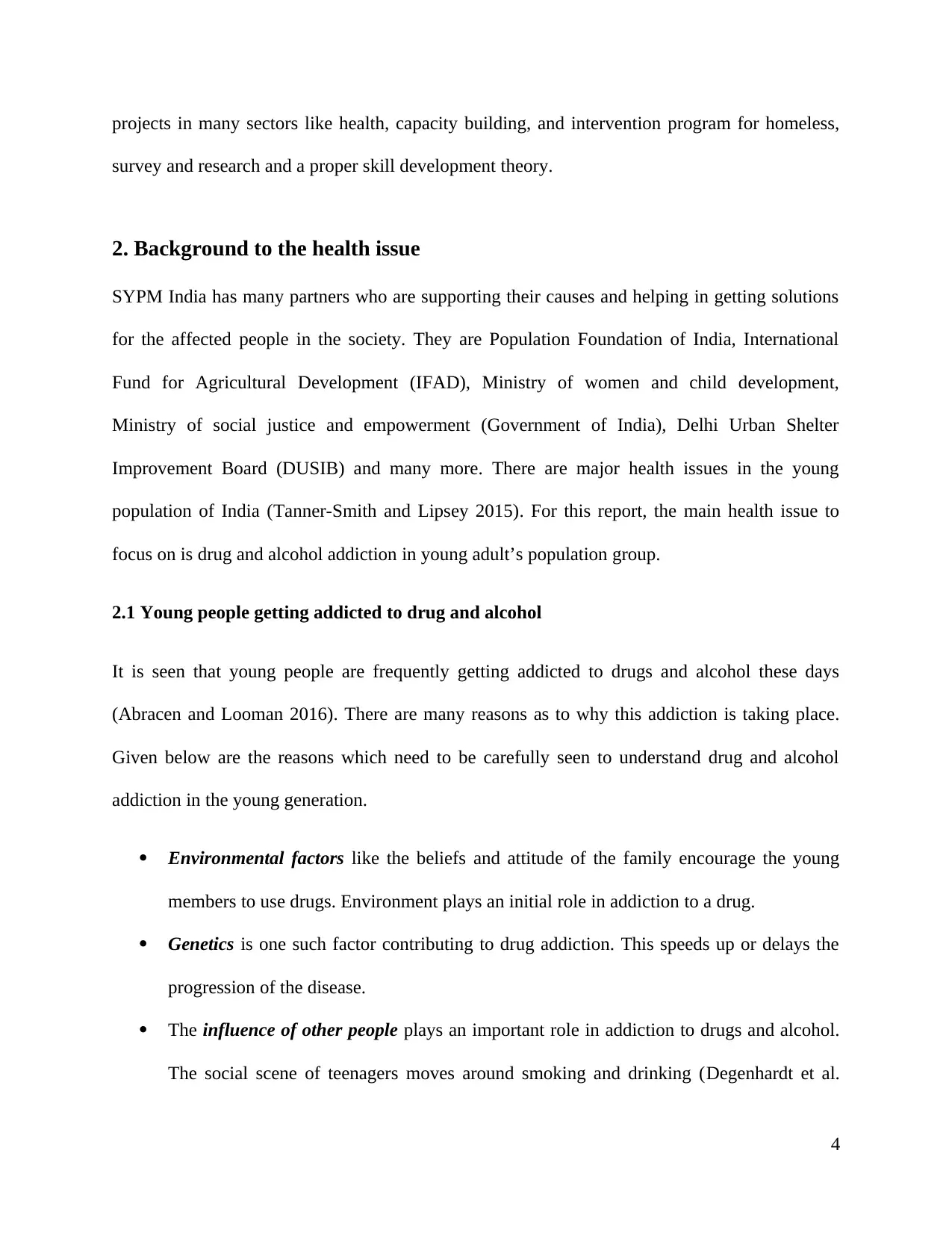
projects in many sectors like health, capacity building, and intervention program for homeless,
survey and research and a proper skill development theory.
2. Background to the health issue
SYPM India has many partners who are supporting their causes and helping in getting solutions
for the affected people in the society. They are Population Foundation of India, International
Fund for Agricultural Development (IFAD), Ministry of women and child development,
Ministry of social justice and empowerment (Government of India), Delhi Urban Shelter
Improvement Board (DUSIB) and many more. There are major health issues in the young
population of India (Tanner-Smith and Lipsey 2015). For this report, the main health issue to
focus on is drug and alcohol addiction in young adult’s population group.
2.1 Young people getting addicted to drug and alcohol
It is seen that young people are frequently getting addicted to drugs and alcohol these days
(Abracen and Looman 2016). There are many reasons as to why this addiction is taking place.
Given below are the reasons which need to be carefully seen to understand drug and alcohol
addiction in the young generation.
Environmental factors like the beliefs and attitude of the family encourage the young
members to use drugs. Environment plays an initial role in addiction to a drug.
Genetics is one such factor contributing to drug addiction. This speeds up or delays the
progression of the disease.
The influence of other people plays an important role in addiction to drugs and alcohol.
The social scene of teenagers moves around smoking and drinking (Degenhardt et al.
4
survey and research and a proper skill development theory.
2. Background to the health issue
SYPM India has many partners who are supporting their causes and helping in getting solutions
for the affected people in the society. They are Population Foundation of India, International
Fund for Agricultural Development (IFAD), Ministry of women and child development,
Ministry of social justice and empowerment (Government of India), Delhi Urban Shelter
Improvement Board (DUSIB) and many more. There are major health issues in the young
population of India (Tanner-Smith and Lipsey 2015). For this report, the main health issue to
focus on is drug and alcohol addiction in young adult’s population group.
2.1 Young people getting addicted to drug and alcohol
It is seen that young people are frequently getting addicted to drugs and alcohol these days
(Abracen and Looman 2016). There are many reasons as to why this addiction is taking place.
Given below are the reasons which need to be carefully seen to understand drug and alcohol
addiction in the young generation.
Environmental factors like the beliefs and attitude of the family encourage the young
members to use drugs. Environment plays an initial role in addiction to a drug.
Genetics is one such factor contributing to drug addiction. This speeds up or delays the
progression of the disease.
The influence of other people plays an important role in addiction to drugs and alcohol.
The social scene of teenagers moves around smoking and drinking (Degenhardt et al.
4
Paraphrase This Document
Need a fresh take? Get an instant paraphrase of this document with our AI Paraphraser
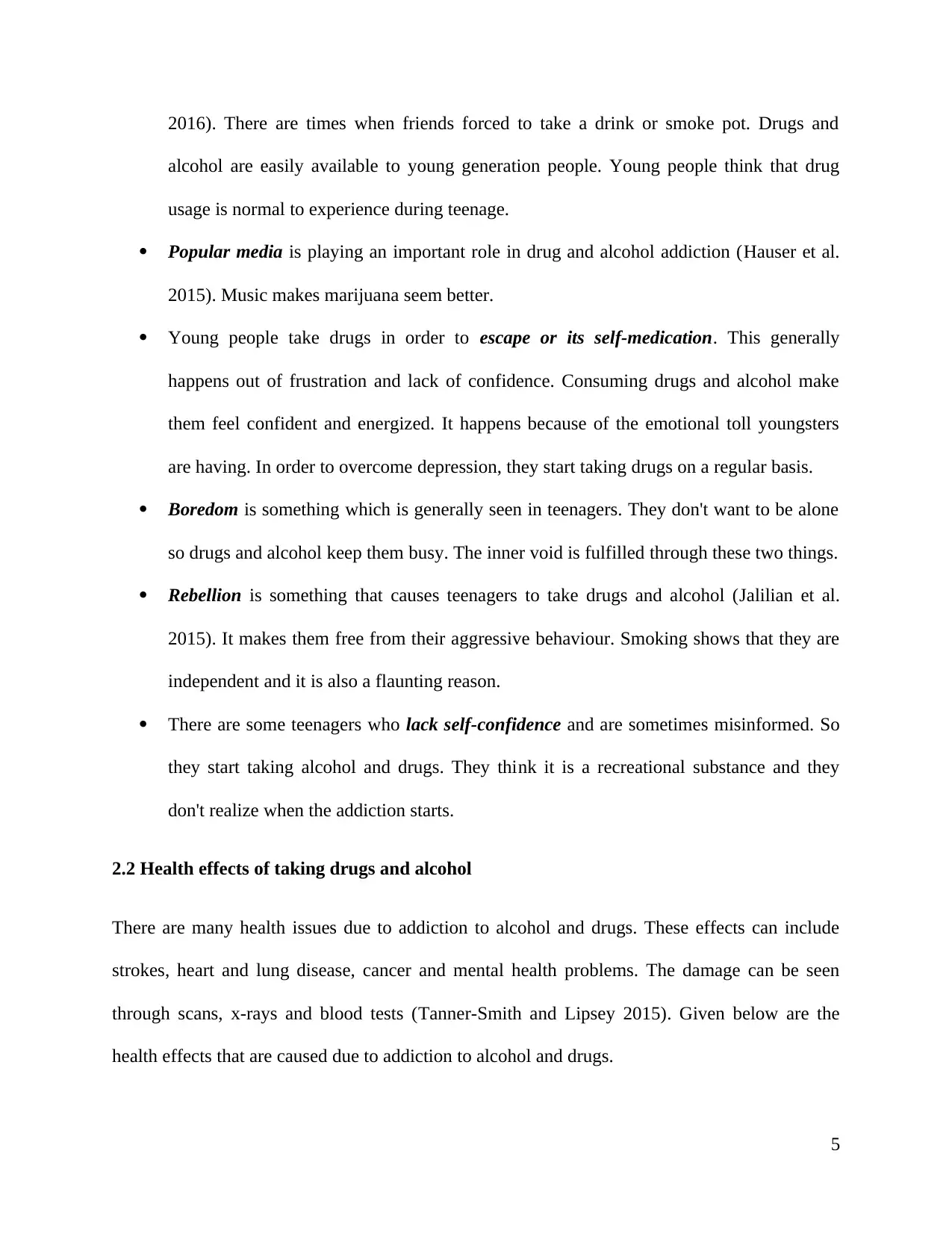
2016). There are times when friends forced to take a drink or smoke pot. Drugs and
alcohol are easily available to young generation people. Young people think that drug
usage is normal to experience during teenage.
Popular media is playing an important role in drug and alcohol addiction (Hauser et al.
2015). Music makes marijuana seem better.
Young people take drugs in order to escape or its self-medication. This generally
happens out of frustration and lack of confidence. Consuming drugs and alcohol make
them feel confident and energized. It happens because of the emotional toll youngsters
are having. In order to overcome depression, they start taking drugs on a regular basis.
Boredom is something which is generally seen in teenagers. They don't want to be alone
so drugs and alcohol keep them busy. The inner void is fulfilled through these two things.
Rebellion is something that causes teenagers to take drugs and alcohol (Jalilian et al.
2015). It makes them free from their aggressive behaviour. Smoking shows that they are
independent and it is also a flaunting reason.
There are some teenagers who lack self-confidence and are sometimes misinformed. So
they start taking alcohol and drugs. They think it is a recreational substance and they
don't realize when the addiction starts.
2.2 Health effects of taking drugs and alcohol
There are many health issues due to addiction to alcohol and drugs. These effects can include
strokes, heart and lung disease, cancer and mental health problems. The damage can be seen
through scans, x-rays and blood tests (Tanner-Smith and Lipsey 2015). Given below are the
health effects that are caused due to addiction to alcohol and drugs.
5
alcohol are easily available to young generation people. Young people think that drug
usage is normal to experience during teenage.
Popular media is playing an important role in drug and alcohol addiction (Hauser et al.
2015). Music makes marijuana seem better.
Young people take drugs in order to escape or its self-medication. This generally
happens out of frustration and lack of confidence. Consuming drugs and alcohol make
them feel confident and energized. It happens because of the emotional toll youngsters
are having. In order to overcome depression, they start taking drugs on a regular basis.
Boredom is something which is generally seen in teenagers. They don't want to be alone
so drugs and alcohol keep them busy. The inner void is fulfilled through these two things.
Rebellion is something that causes teenagers to take drugs and alcohol (Jalilian et al.
2015). It makes them free from their aggressive behaviour. Smoking shows that they are
independent and it is also a flaunting reason.
There are some teenagers who lack self-confidence and are sometimes misinformed. So
they start taking alcohol and drugs. They think it is a recreational substance and they
don't realize when the addiction starts.
2.2 Health effects of taking drugs and alcohol
There are many health issues due to addiction to alcohol and drugs. These effects can include
strokes, heart and lung disease, cancer and mental health problems. The damage can be seen
through scans, x-rays and blood tests (Tanner-Smith and Lipsey 2015). Given below are the
health effects that are caused due to addiction to alcohol and drugs.
5
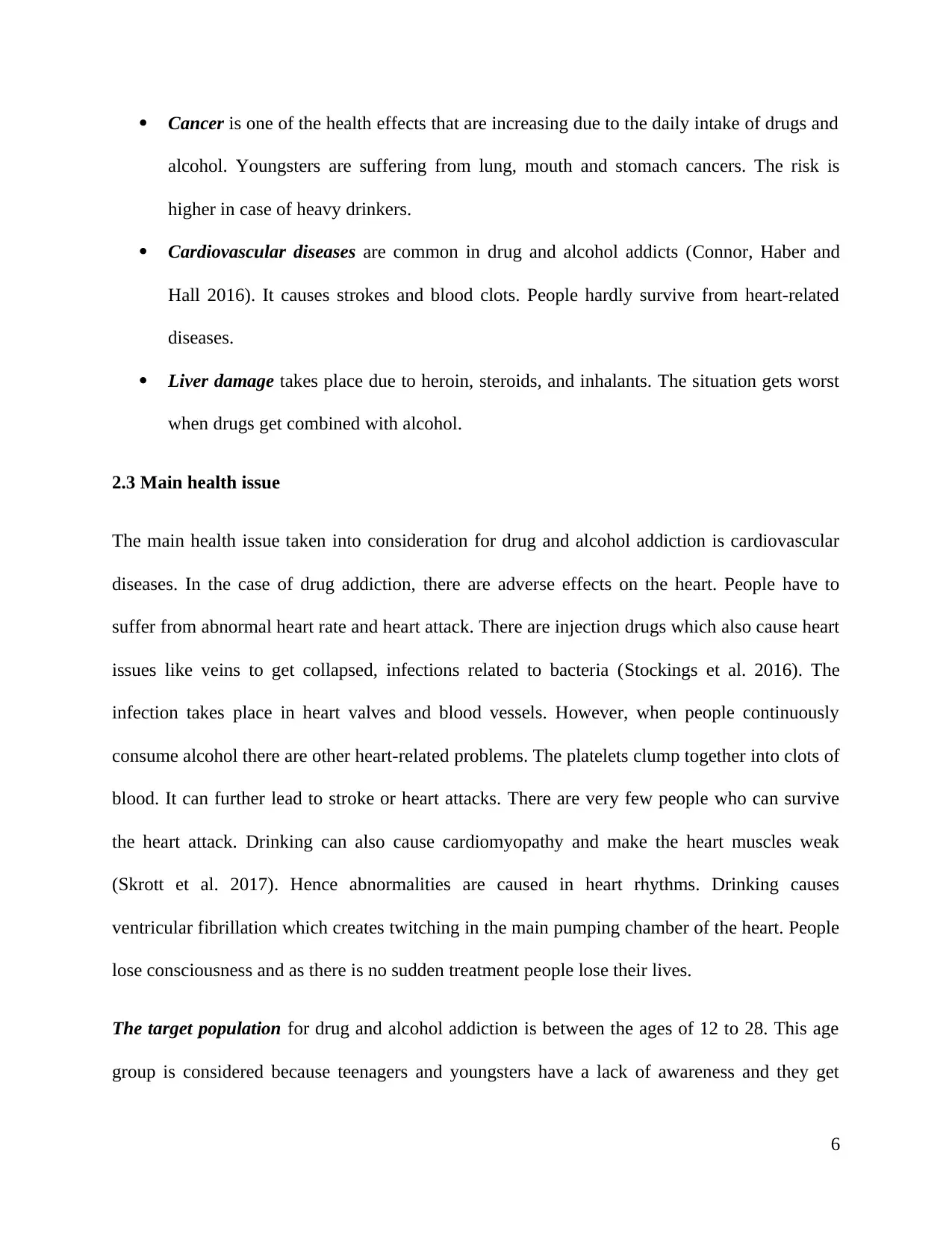
Cancer is one of the health effects that are increasing due to the daily intake of drugs and
alcohol. Youngsters are suffering from lung, mouth and stomach cancers. The risk is
higher in case of heavy drinkers.
Cardiovascular diseases are common in drug and alcohol addicts (Connor, Haber and
Hall 2016). It causes strokes and blood clots. People hardly survive from heart-related
diseases.
Liver damage takes place due to heroin, steroids, and inhalants. The situation gets worst
when drugs get combined with alcohol.
2.3 Main health issue
The main health issue taken into consideration for drug and alcohol addiction is cardiovascular
diseases. In the case of drug addiction, there are adverse effects on the heart. People have to
suffer from abnormal heart rate and heart attack. There are injection drugs which also cause heart
issues like veins to get collapsed, infections related to bacteria (Stockings et al. 2016). The
infection takes place in heart valves and blood vessels. However, when people continuously
consume alcohol there are other heart-related problems. The platelets clump together into clots of
blood. It can further lead to stroke or heart attacks. There are very few people who can survive
the heart attack. Drinking can also cause cardiomyopathy and make the heart muscles weak
(Skrott et al. 2017). Hence abnormalities are caused in heart rhythms. Drinking causes
ventricular fibrillation which creates twitching in the main pumping chamber of the heart. People
lose consciousness and as there is no sudden treatment people lose their lives.
The target population for drug and alcohol addiction is between the ages of 12 to 28. This age
group is considered because teenagers and youngsters have a lack of awareness and they get
6
alcohol. Youngsters are suffering from lung, mouth and stomach cancers. The risk is
higher in case of heavy drinkers.
Cardiovascular diseases are common in drug and alcohol addicts (Connor, Haber and
Hall 2016). It causes strokes and blood clots. People hardly survive from heart-related
diseases.
Liver damage takes place due to heroin, steroids, and inhalants. The situation gets worst
when drugs get combined with alcohol.
2.3 Main health issue
The main health issue taken into consideration for drug and alcohol addiction is cardiovascular
diseases. In the case of drug addiction, there are adverse effects on the heart. People have to
suffer from abnormal heart rate and heart attack. There are injection drugs which also cause heart
issues like veins to get collapsed, infections related to bacteria (Stockings et al. 2016). The
infection takes place in heart valves and blood vessels. However, when people continuously
consume alcohol there are other heart-related problems. The platelets clump together into clots of
blood. It can further lead to stroke or heart attacks. There are very few people who can survive
the heart attack. Drinking can also cause cardiomyopathy and make the heart muscles weak
(Skrott et al. 2017). Hence abnormalities are caused in heart rhythms. Drinking causes
ventricular fibrillation which creates twitching in the main pumping chamber of the heart. People
lose consciousness and as there is no sudden treatment people lose their lives.
The target population for drug and alcohol addiction is between the ages of 12 to 28. This age
group is considered because teenagers and youngsters have a lack of awareness and they get
6
⊘ This is a preview!⊘
Do you want full access?
Subscribe today to unlock all pages.

Trusted by 1+ million students worldwide
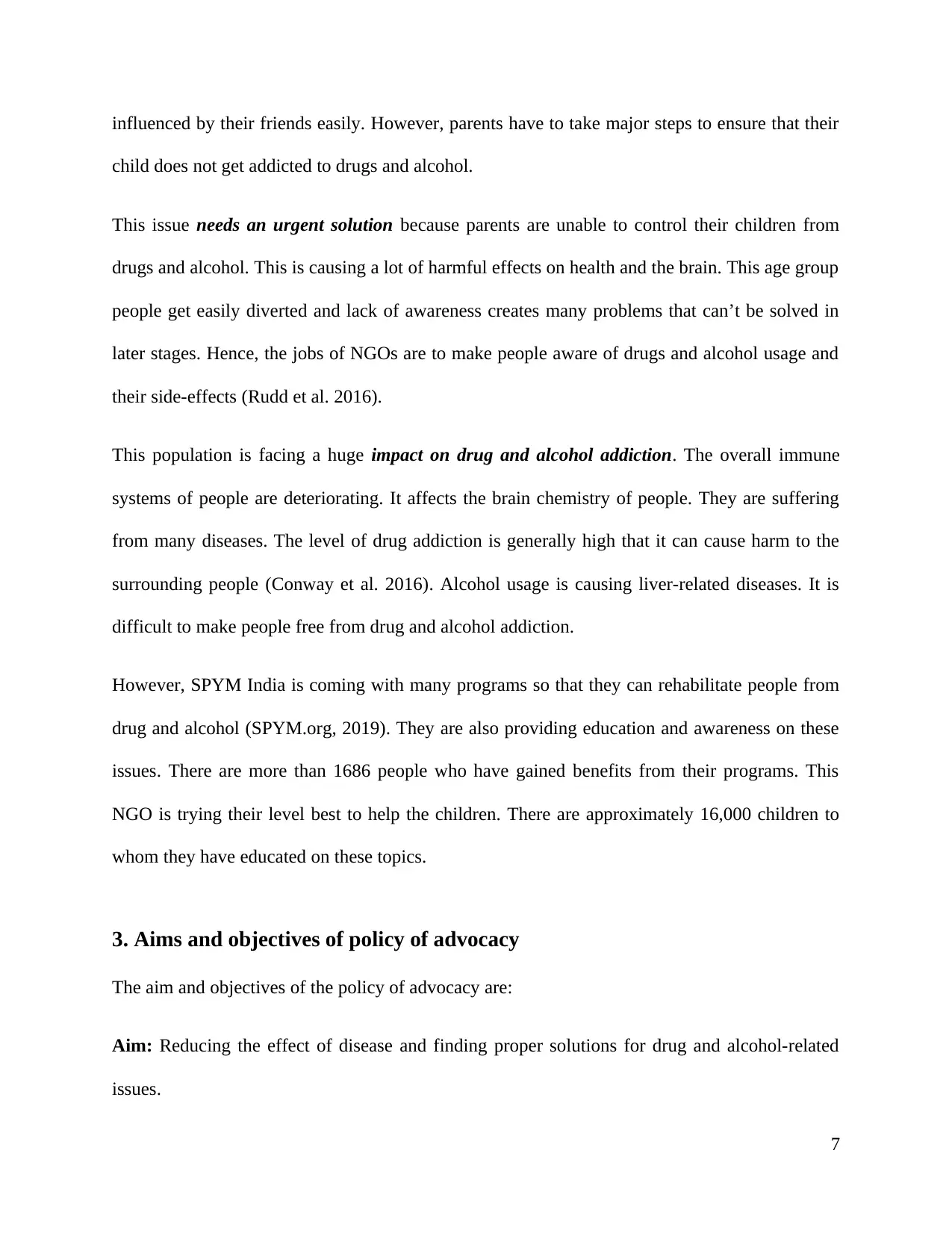
influenced by their friends easily. However, parents have to take major steps to ensure that their
child does not get addicted to drugs and alcohol.
This issue needs an urgent solution because parents are unable to control their children from
drugs and alcohol. This is causing a lot of harmful effects on health and the brain. This age group
people get easily diverted and lack of awareness creates many problems that can’t be solved in
later stages. Hence, the jobs of NGOs are to make people aware of drugs and alcohol usage and
their side-effects (Rudd et al. 2016).
This population is facing a huge impact on drug and alcohol addiction. The overall immune
systems of people are deteriorating. It affects the brain chemistry of people. They are suffering
from many diseases. The level of drug addiction is generally high that it can cause harm to the
surrounding people (Conway et al. 2016). Alcohol usage is causing liver-related diseases. It is
difficult to make people free from drug and alcohol addiction.
However, SPYM India is coming with many programs so that they can rehabilitate people from
drug and alcohol (SPYM.org, 2019). They are also providing education and awareness on these
issues. There are more than 1686 people who have gained benefits from their programs. This
NGO is trying their level best to help the children. There are approximately 16,000 children to
whom they have educated on these topics.
3. Aims and objectives of policy of advocacy
The aim and objectives of the policy of advocacy are:
Aim: Reducing the effect of disease and finding proper solutions for drug and alcohol-related
issues.
7
child does not get addicted to drugs and alcohol.
This issue needs an urgent solution because parents are unable to control their children from
drugs and alcohol. This is causing a lot of harmful effects on health and the brain. This age group
people get easily diverted and lack of awareness creates many problems that can’t be solved in
later stages. Hence, the jobs of NGOs are to make people aware of drugs and alcohol usage and
their side-effects (Rudd et al. 2016).
This population is facing a huge impact on drug and alcohol addiction. The overall immune
systems of people are deteriorating. It affects the brain chemistry of people. They are suffering
from many diseases. The level of drug addiction is generally high that it can cause harm to the
surrounding people (Conway et al. 2016). Alcohol usage is causing liver-related diseases. It is
difficult to make people free from drug and alcohol addiction.
However, SPYM India is coming with many programs so that they can rehabilitate people from
drug and alcohol (SPYM.org, 2019). They are also providing education and awareness on these
issues. There are more than 1686 people who have gained benefits from their programs. This
NGO is trying their level best to help the children. There are approximately 16,000 children to
whom they have educated on these topics.
3. Aims and objectives of policy of advocacy
The aim and objectives of the policy of advocacy are:
Aim: Reducing the effect of disease and finding proper solutions for drug and alcohol-related
issues.
7
Paraphrase This Document
Need a fresh take? Get an instant paraphrase of this document with our AI Paraphraser
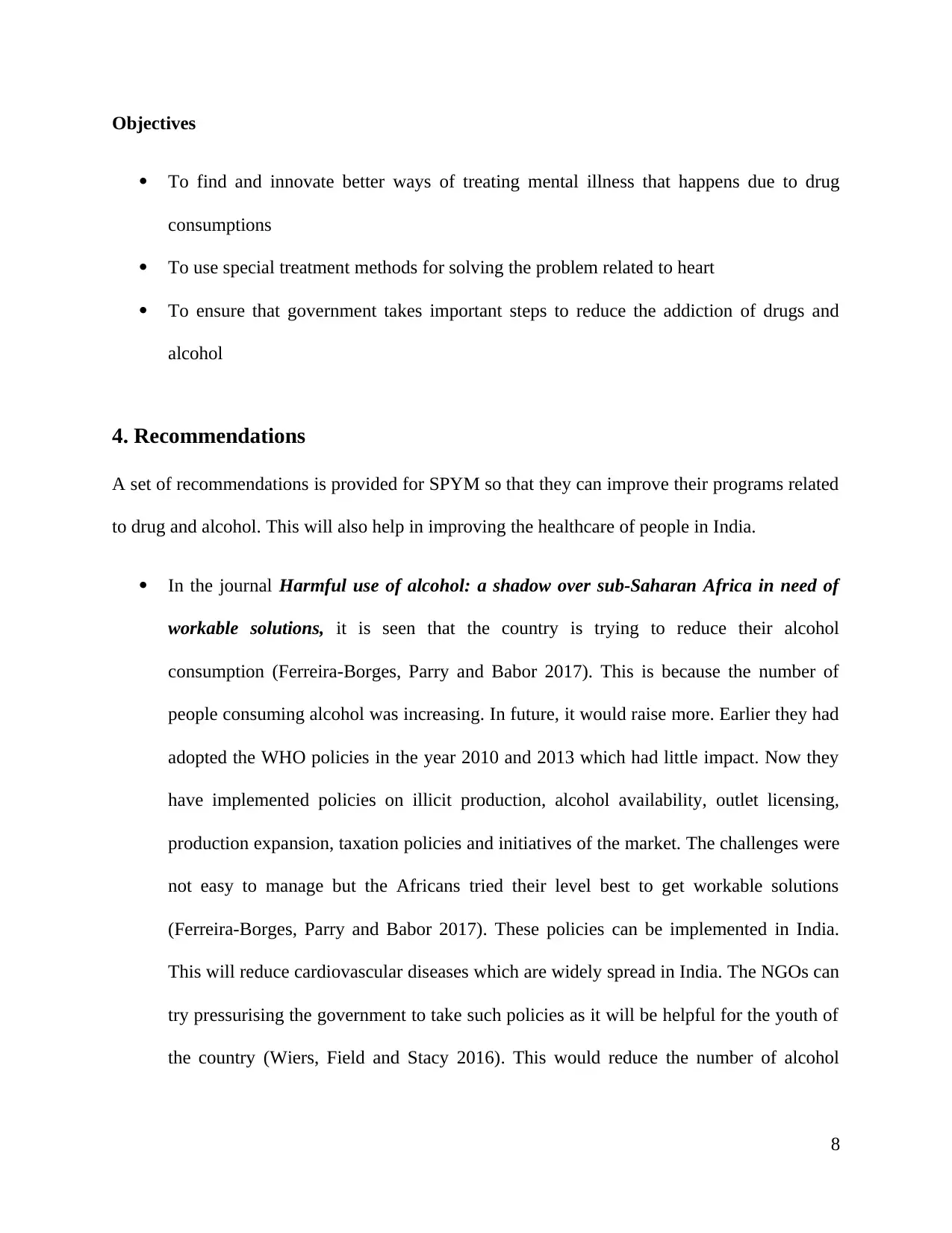
Objectives
To find and innovate better ways of treating mental illness that happens due to drug
consumptions
To use special treatment methods for solving the problem related to heart
To ensure that government takes important steps to reduce the addiction of drugs and
alcohol
4. Recommendations
A set of recommendations is provided for SPYM so that they can improve their programs related
to drug and alcohol. This will also help in improving the healthcare of people in India.
In the journal Harmful use of alcohol: a shadow over sub-Saharan Africa in need of
workable solutions, it is seen that the country is trying to reduce their alcohol
consumption (Ferreira-Borges, Parry and Babor 2017). This is because the number of
people consuming alcohol was increasing. In future, it would raise more. Earlier they had
adopted the WHO policies in the year 2010 and 2013 which had little impact. Now they
have implemented policies on illicit production, alcohol availability, outlet licensing,
production expansion, taxation policies and initiatives of the market. The challenges were
not easy to manage but the Africans tried their level best to get workable solutions
(Ferreira-Borges, Parry and Babor 2017). These policies can be implemented in India.
This will reduce cardiovascular diseases which are widely spread in India. The NGOs can
try pressurising the government to take such policies as it will be helpful for the youth of
the country (Wiers, Field and Stacy 2016). This would reduce the number of alcohol
8
To find and innovate better ways of treating mental illness that happens due to drug
consumptions
To use special treatment methods for solving the problem related to heart
To ensure that government takes important steps to reduce the addiction of drugs and
alcohol
4. Recommendations
A set of recommendations is provided for SPYM so that they can improve their programs related
to drug and alcohol. This will also help in improving the healthcare of people in India.
In the journal Harmful use of alcohol: a shadow over sub-Saharan Africa in need of
workable solutions, it is seen that the country is trying to reduce their alcohol
consumption (Ferreira-Borges, Parry and Babor 2017). This is because the number of
people consuming alcohol was increasing. In future, it would raise more. Earlier they had
adopted the WHO policies in the year 2010 and 2013 which had little impact. Now they
have implemented policies on illicit production, alcohol availability, outlet licensing,
production expansion, taxation policies and initiatives of the market. The challenges were
not easy to manage but the Africans tried their level best to get workable solutions
(Ferreira-Borges, Parry and Babor 2017). These policies can be implemented in India.
This will reduce cardiovascular diseases which are widely spread in India. The NGOs can
try pressurising the government to take such policies as it will be helpful for the youth of
the country (Wiers, Field and Stacy 2016). This would reduce the number of alcohol
8
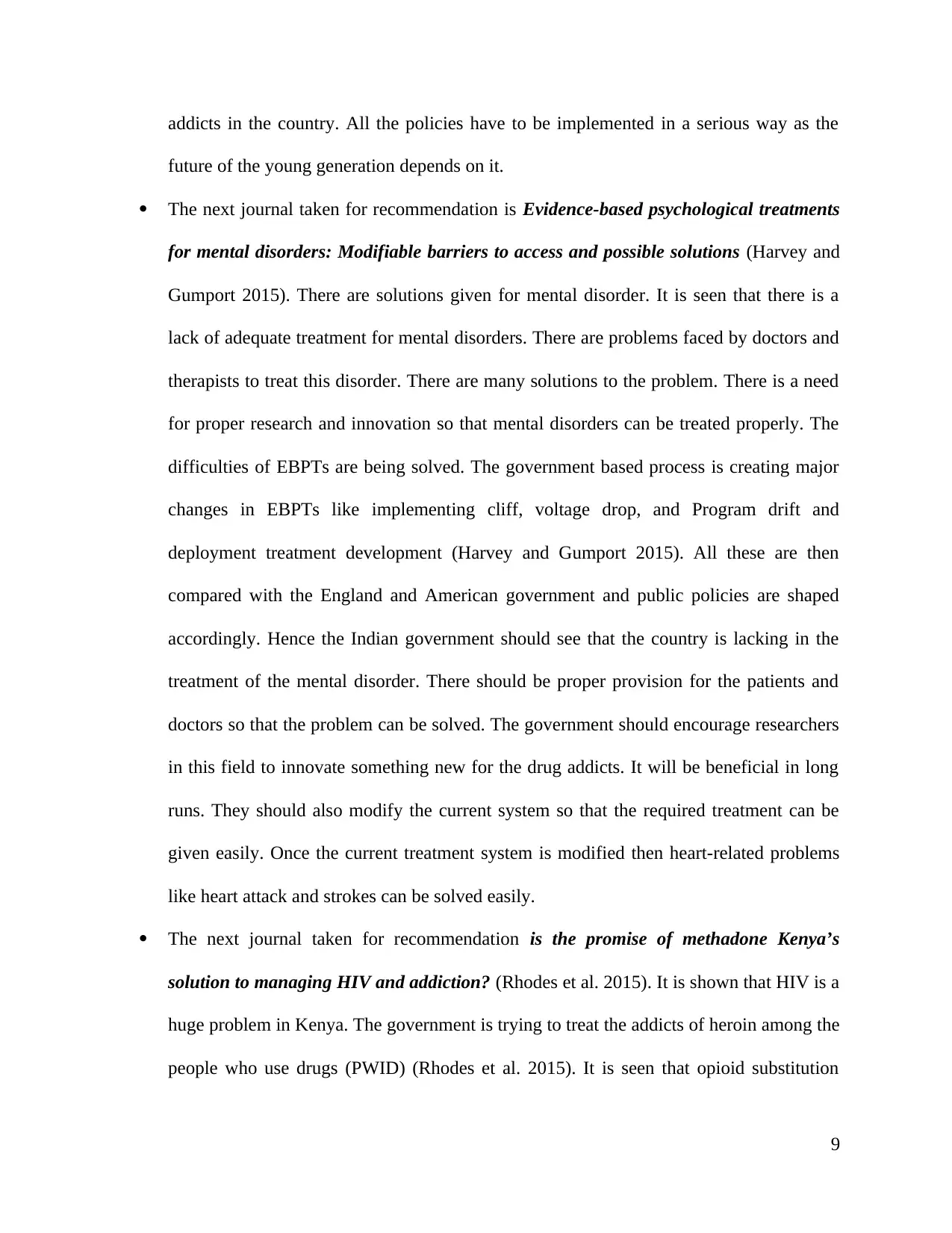
addicts in the country. All the policies have to be implemented in a serious way as the
future of the young generation depends on it.
The next journal taken for recommendation is Evidence-based psychological treatments
for mental disorders: Modifiable barriers to access and possible solutions (Harvey and
Gumport 2015). There are solutions given for mental disorder. It is seen that there is a
lack of adequate treatment for mental disorders. There are problems faced by doctors and
therapists to treat this disorder. There are many solutions to the problem. There is a need
for proper research and innovation so that mental disorders can be treated properly. The
difficulties of EBPTs are being solved. The government based process is creating major
changes in EBPTs like implementing cliff, voltage drop, and Program drift and
deployment treatment development (Harvey and Gumport 2015). All these are then
compared with the England and American government and public policies are shaped
accordingly. Hence the Indian government should see that the country is lacking in the
treatment of the mental disorder. There should be proper provision for the patients and
doctors so that the problem can be solved. The government should encourage researchers
in this field to innovate something new for the drug addicts. It will be beneficial in long
runs. They should also modify the current system so that the required treatment can be
given easily. Once the current treatment system is modified then heart-related problems
like heart attack and strokes can be solved easily.
The next journal taken for recommendation is the promise of methadone Kenya’s
solution to managing HIV and addiction? (Rhodes et al. 2015). It is shown that HIV is a
huge problem in Kenya. The government is trying to treat the addicts of heroin among the
people who use drugs (PWID) (Rhodes et al. 2015). It is seen that opioid substitution
9
future of the young generation depends on it.
The next journal taken for recommendation is Evidence-based psychological treatments
for mental disorders: Modifiable barriers to access and possible solutions (Harvey and
Gumport 2015). There are solutions given for mental disorder. It is seen that there is a
lack of adequate treatment for mental disorders. There are problems faced by doctors and
therapists to treat this disorder. There are many solutions to the problem. There is a need
for proper research and innovation so that mental disorders can be treated properly. The
difficulties of EBPTs are being solved. The government based process is creating major
changes in EBPTs like implementing cliff, voltage drop, and Program drift and
deployment treatment development (Harvey and Gumport 2015). All these are then
compared with the England and American government and public policies are shaped
accordingly. Hence the Indian government should see that the country is lacking in the
treatment of the mental disorder. There should be proper provision for the patients and
doctors so that the problem can be solved. The government should encourage researchers
in this field to innovate something new for the drug addicts. It will be beneficial in long
runs. They should also modify the current system so that the required treatment can be
given easily. Once the current treatment system is modified then heart-related problems
like heart attack and strokes can be solved easily.
The next journal taken for recommendation is the promise of methadone Kenya’s
solution to managing HIV and addiction? (Rhodes et al. 2015). It is shown that HIV is a
huge problem in Kenya. The government is trying to treat the addicts of heroin among the
people who use drugs (PWID) (Rhodes et al. 2015). It is seen that opioid substitution
9
⊘ This is a preview!⊘
Do you want full access?
Subscribe today to unlock all pages.

Trusted by 1+ million students worldwide
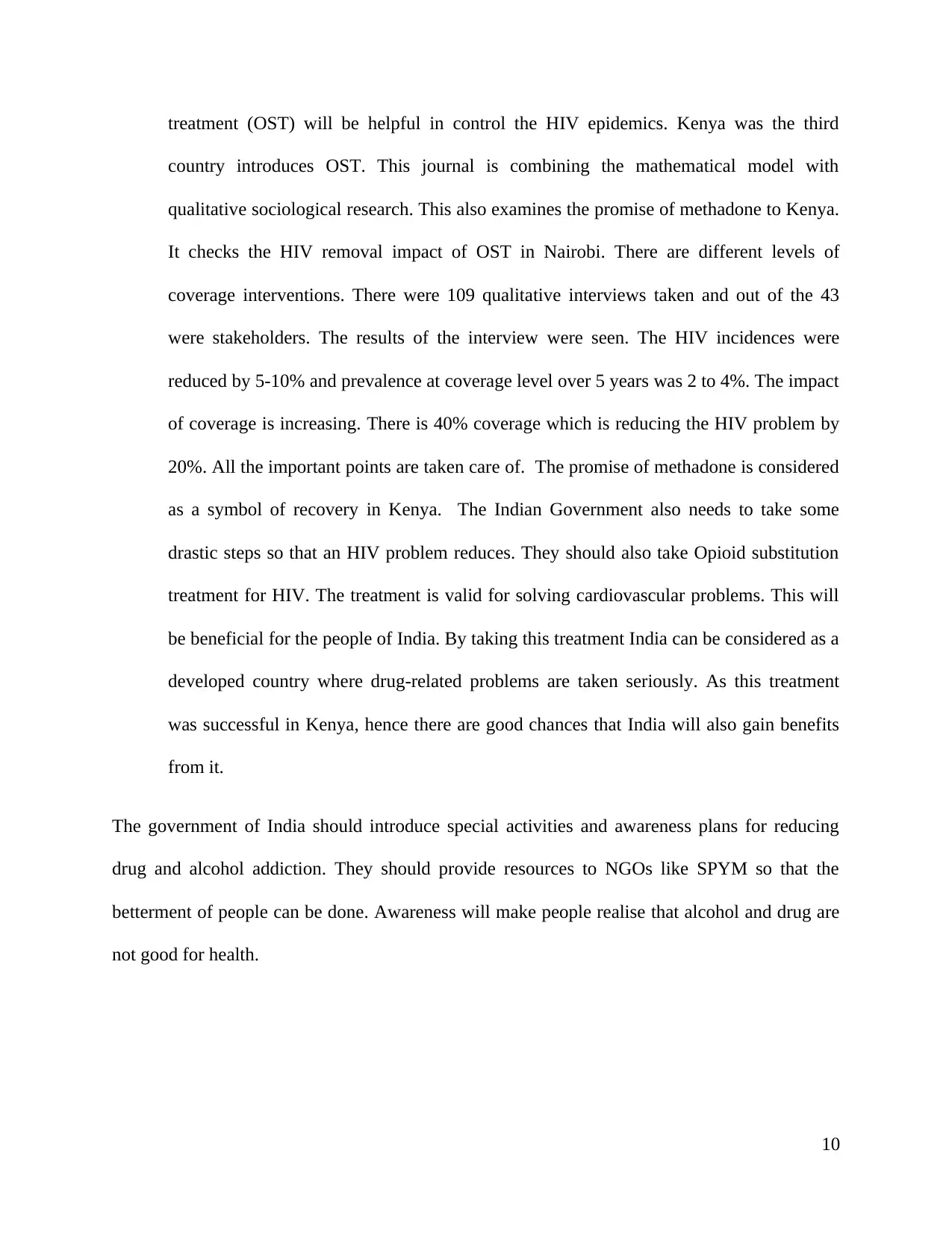
treatment (OST) will be helpful in control the HIV epidemics. Kenya was the third
country introduces OST. This journal is combining the mathematical model with
qualitative sociological research. This also examines the promise of methadone to Kenya.
It checks the HIV removal impact of OST in Nairobi. There are different levels of
coverage interventions. There were 109 qualitative interviews taken and out of the 43
were stakeholders. The results of the interview were seen. The HIV incidences were
reduced by 5-10% and prevalence at coverage level over 5 years was 2 to 4%. The impact
of coverage is increasing. There is 40% coverage which is reducing the HIV problem by
20%. All the important points are taken care of. The promise of methadone is considered
as a symbol of recovery in Kenya. The Indian Government also needs to take some
drastic steps so that an HIV problem reduces. They should also take Opioid substitution
treatment for HIV. The treatment is valid for solving cardiovascular problems. This will
be beneficial for the people of India. By taking this treatment India can be considered as a
developed country where drug-related problems are taken seriously. As this treatment
was successful in Kenya, hence there are good chances that India will also gain benefits
from it.
The government of India should introduce special activities and awareness plans for reducing
drug and alcohol addiction. They should provide resources to NGOs like SPYM so that the
betterment of people can be done. Awareness will make people realise that alcohol and drug are
not good for health.
10
country introduces OST. This journal is combining the mathematical model with
qualitative sociological research. This also examines the promise of methadone to Kenya.
It checks the HIV removal impact of OST in Nairobi. There are different levels of
coverage interventions. There were 109 qualitative interviews taken and out of the 43
were stakeholders. The results of the interview were seen. The HIV incidences were
reduced by 5-10% and prevalence at coverage level over 5 years was 2 to 4%. The impact
of coverage is increasing. There is 40% coverage which is reducing the HIV problem by
20%. All the important points are taken care of. The promise of methadone is considered
as a symbol of recovery in Kenya. The Indian Government also needs to take some
drastic steps so that an HIV problem reduces. They should also take Opioid substitution
treatment for HIV. The treatment is valid for solving cardiovascular problems. This will
be beneficial for the people of India. By taking this treatment India can be considered as a
developed country where drug-related problems are taken seriously. As this treatment
was successful in Kenya, hence there are good chances that India will also gain benefits
from it.
The government of India should introduce special activities and awareness plans for reducing
drug and alcohol addiction. They should provide resources to NGOs like SPYM so that the
betterment of people can be done. Awareness will make people realise that alcohol and drug are
not good for health.
10
Paraphrase This Document
Need a fresh take? Get an instant paraphrase of this document with our AI Paraphraser
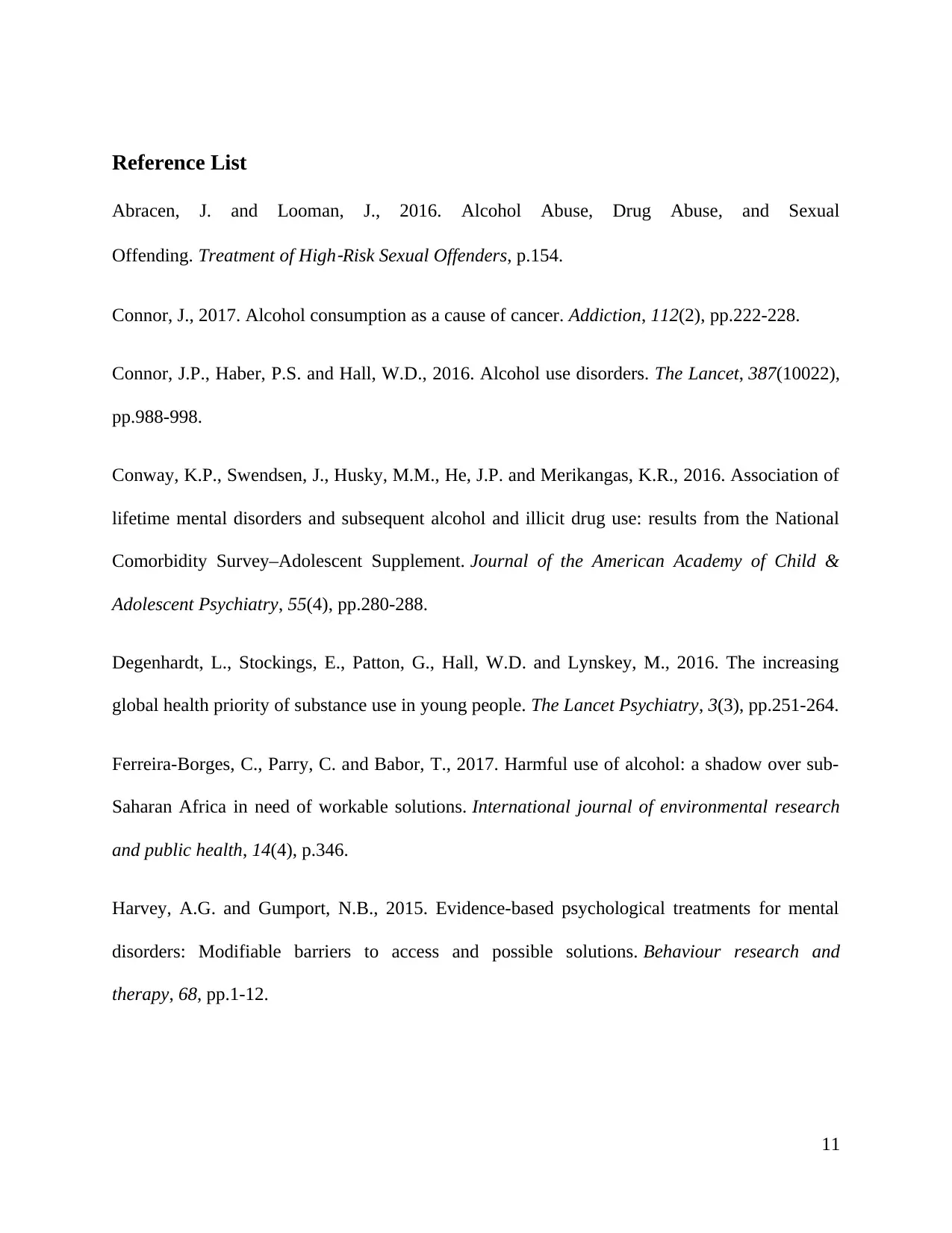
Reference List
Abracen, J. and Looman, J., 2016. Alcohol Abuse, Drug Abuse, and Sexual
Offending. Treatment of High
‐Risk Sexual Offenders, p.154.
Connor, J., 2017. Alcohol consumption as a cause of cancer. Addiction, 112(2), pp.222-228.
Connor, J.P., Haber, P.S. and Hall, W.D., 2016. Alcohol use disorders. The Lancet, 387(10022),
pp.988-998.
Conway, K.P., Swendsen, J., Husky, M.M., He, J.P. and Merikangas, K.R., 2016. Association of
lifetime mental disorders and subsequent alcohol and illicit drug use: results from the National
Comorbidity Survey–Adolescent Supplement. Journal of the American Academy of Child &
Adolescent Psychiatry, 55(4), pp.280-288.
Degenhardt, L., Stockings, E., Patton, G., Hall, W.D. and Lynskey, M., 2016. The increasing
global health priority of substance use in young people. The Lancet Psychiatry, 3(3), pp.251-264.
Ferreira-Borges, C., Parry, C. and Babor, T., 2017. Harmful use of alcohol: a shadow over sub-
Saharan Africa in need of workable solutions. International journal of environmental research
and public health, 14(4), p.346.
Harvey, A.G. and Gumport, N.B., 2015. Evidence-based psychological treatments for mental
disorders: Modifiable barriers to access and possible solutions. Behaviour research and
therapy, 68, pp.1-12.
11
Abracen, J. and Looman, J., 2016. Alcohol Abuse, Drug Abuse, and Sexual
Offending. Treatment of High
‐Risk Sexual Offenders, p.154.
Connor, J., 2017. Alcohol consumption as a cause of cancer. Addiction, 112(2), pp.222-228.
Connor, J.P., Haber, P.S. and Hall, W.D., 2016. Alcohol use disorders. The Lancet, 387(10022),
pp.988-998.
Conway, K.P., Swendsen, J., Husky, M.M., He, J.P. and Merikangas, K.R., 2016. Association of
lifetime mental disorders and subsequent alcohol and illicit drug use: results from the National
Comorbidity Survey–Adolescent Supplement. Journal of the American Academy of Child &
Adolescent Psychiatry, 55(4), pp.280-288.
Degenhardt, L., Stockings, E., Patton, G., Hall, W.D. and Lynskey, M., 2016. The increasing
global health priority of substance use in young people. The Lancet Psychiatry, 3(3), pp.251-264.
Ferreira-Borges, C., Parry, C. and Babor, T., 2017. Harmful use of alcohol: a shadow over sub-
Saharan Africa in need of workable solutions. International journal of environmental research
and public health, 14(4), p.346.
Harvey, A.G. and Gumport, N.B., 2015. Evidence-based psychological treatments for mental
disorders: Modifiable barriers to access and possible solutions. Behaviour research and
therapy, 68, pp.1-12.
11
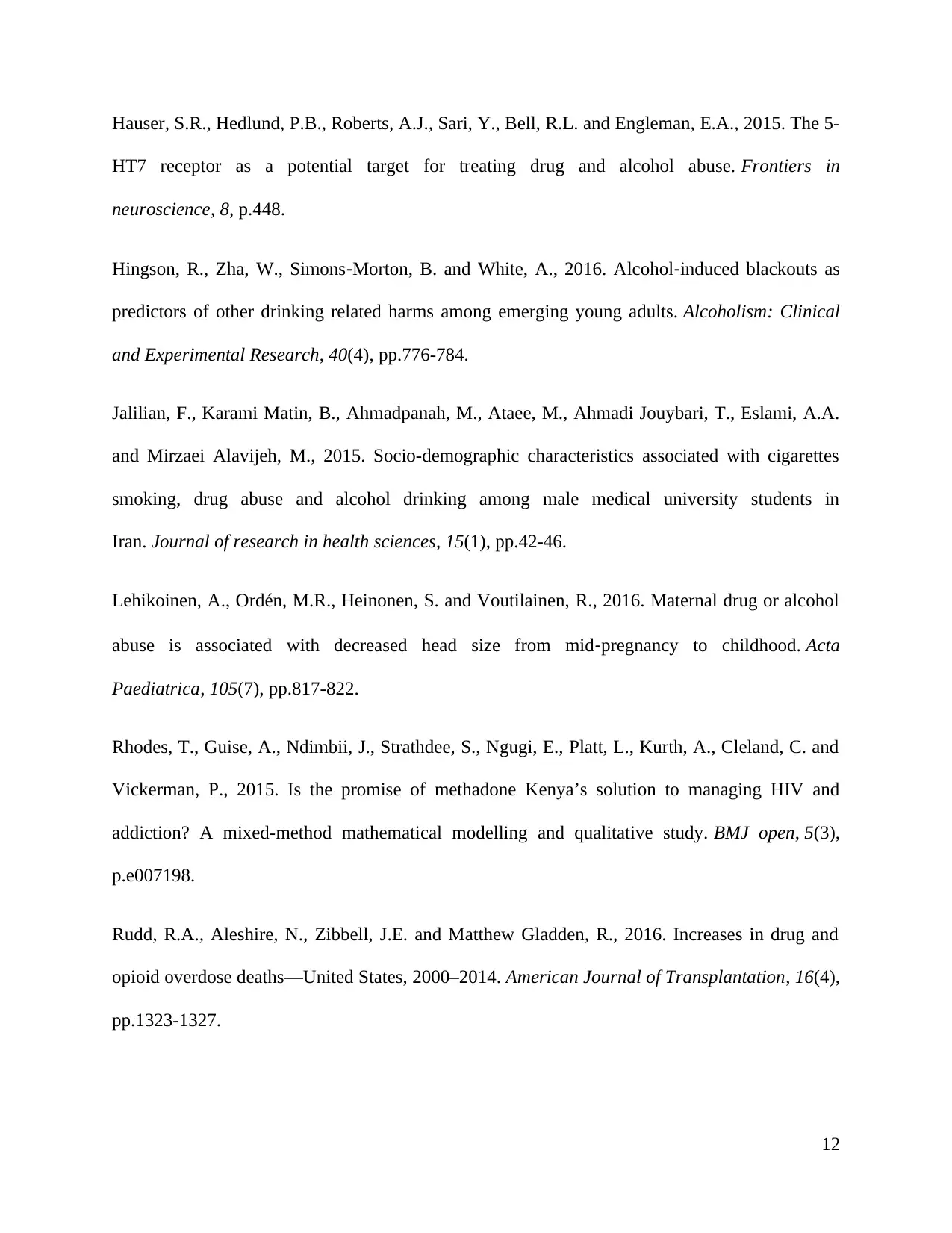
Hauser, S.R., Hedlund, P.B., Roberts, A.J., Sari, Y., Bell, R.L. and Engleman, E.A., 2015. The 5-
HT7 receptor as a potential target for treating drug and alcohol abuse. Frontiers in
neuroscience, 8, p.448.
Hingson, R., Zha, W., Simons‐Morton, B. and White, A., 2016. Alcohol‐induced blackouts as
predictors of other drinking related harms among emerging young adults. Alcoholism: Clinical
and Experimental Research, 40(4), pp.776-784.
Jalilian, F., Karami Matin, B., Ahmadpanah, M., Ataee, M., Ahmadi Jouybari, T., Eslami, A.A.
and Mirzaei Alavijeh, M., 2015. Socio-demographic characteristics associated with cigarettes
smoking, drug abuse and alcohol drinking among male medical university students in
Iran. Journal of research in health sciences, 15(1), pp.42-46.
Lehikoinen, A., Ordén, M.R., Heinonen, S. and Voutilainen, R., 2016. Maternal drug or alcohol
abuse is associated with decreased head size from mid‐pregnancy to childhood. Acta
Paediatrica, 105(7), pp.817-822.
Rhodes, T., Guise, A., Ndimbii, J., Strathdee, S., Ngugi, E., Platt, L., Kurth, A., Cleland, C. and
Vickerman, P., 2015. Is the promise of methadone Kenya’s solution to managing HIV and
addiction? A mixed-method mathematical modelling and qualitative study. BMJ open, 5(3),
p.e007198.
Rudd, R.A., Aleshire, N., Zibbell, J.E. and Matthew Gladden, R., 2016. Increases in drug and
opioid overdose deaths—United States, 2000–2014. American Journal of Transplantation, 16(4),
pp.1323-1327.
12
HT7 receptor as a potential target for treating drug and alcohol abuse. Frontiers in
neuroscience, 8, p.448.
Hingson, R., Zha, W., Simons‐Morton, B. and White, A., 2016. Alcohol‐induced blackouts as
predictors of other drinking related harms among emerging young adults. Alcoholism: Clinical
and Experimental Research, 40(4), pp.776-784.
Jalilian, F., Karami Matin, B., Ahmadpanah, M., Ataee, M., Ahmadi Jouybari, T., Eslami, A.A.
and Mirzaei Alavijeh, M., 2015. Socio-demographic characteristics associated with cigarettes
smoking, drug abuse and alcohol drinking among male medical university students in
Iran. Journal of research in health sciences, 15(1), pp.42-46.
Lehikoinen, A., Ordén, M.R., Heinonen, S. and Voutilainen, R., 2016. Maternal drug or alcohol
abuse is associated with decreased head size from mid‐pregnancy to childhood. Acta
Paediatrica, 105(7), pp.817-822.
Rhodes, T., Guise, A., Ndimbii, J., Strathdee, S., Ngugi, E., Platt, L., Kurth, A., Cleland, C. and
Vickerman, P., 2015. Is the promise of methadone Kenya’s solution to managing HIV and
addiction? A mixed-method mathematical modelling and qualitative study. BMJ open, 5(3),
p.e007198.
Rudd, R.A., Aleshire, N., Zibbell, J.E. and Matthew Gladden, R., 2016. Increases in drug and
opioid overdose deaths—United States, 2000–2014. American Journal of Transplantation, 16(4),
pp.1323-1327.
12
⊘ This is a preview!⊘
Do you want full access?
Subscribe today to unlock all pages.

Trusted by 1+ million students worldwide
1 out of 14
Related Documents
Your All-in-One AI-Powered Toolkit for Academic Success.
+13062052269
info@desklib.com
Available 24*7 on WhatsApp / Email
![[object Object]](/_next/static/media/star-bottom.7253800d.svg)
Unlock your academic potential
Copyright © 2020–2025 A2Z Services. All Rights Reserved. Developed and managed by ZUCOL.





